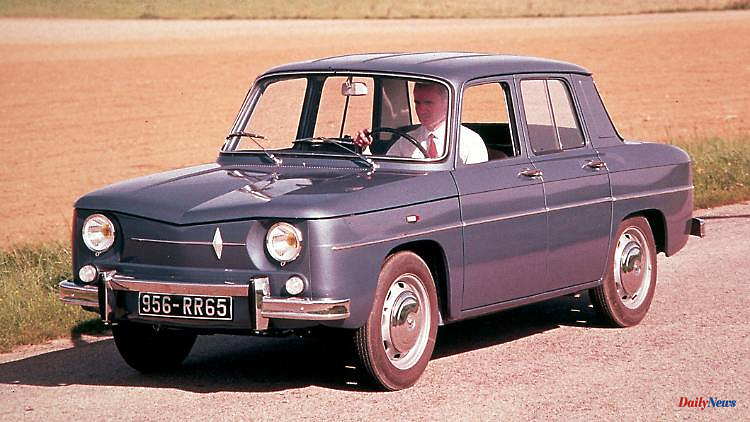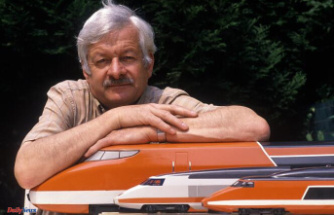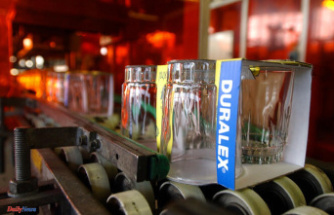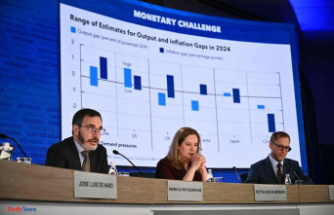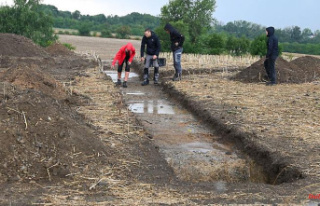Blue with white stripes, the Renault 8 of the works tuner Gordini warn of their racing talents. Even Abarth or Porsche drivers feared this French color scheme in the racing-mad 1960s. But the R8 also made history as an everyday hero, especially when Dacia was founded.
In the early post-war years, not only did the VW Beetle climb the sales charts with power from behind, but the French Régie Renault also successfully relied on the combination of rear engine and rear-wheel drive. Packed in seductive shapes, compact four-door models à la Renault 4 CV and Dauphine met global tastes from Japan to North America in the 1950s, so that the brand with the rhombus was certain: The Renault 8 presented in 1962 should also compete with the Opel Kadett, Ford Taunus 12M, Fiat 1100 or Simca 1000 succeed.
No futuristic front-wheel drive like the cheeky R4, but a modern 1.0-liter four-cylinder with five-bearing crankshaft and overhead camshaft in the rear. In addition to the relatively spacious trunk under the front hood, the standard four-door and 3.99 meter short R8 did justice to the zeitgeist of the economic miracle. Even in the USA, this "New Generation Economy Car" dressed in a chic trapezoidal shape at the "Pocketbook" price caused a sensation, especially since a sticker "Special USA made in France" assured that Renault had learned from the quality deficits of earlier models.
The slightly larger Renault 10, stretched to a length of 4.20 meters, continued this R8 concept in 1965. But the idea of putting the engine behind the passengers now seemed outdated at Renault too. Nevertheless, an engine magician by the name of Amédée Gordini succeeded in erecting a monument for eternity to the rear-wheel drive R8 - as the forerunner of the hotter GTI and furious RS.
Since 1957, many of the sportiest Renaults have borne the name of this brilliant tuner, racing driver and businessman: Amédée Gordini made the Dauphine fit for race victories in particular, after he had previously established himself as the second strongest force behind Ferrari with monoposti in Formula 2. Then came the Renault 8 in 1962 as the designated successor to the Dauphine, and the managers in Billancourt immediately began to think about wild motorsport versions of the good four-door car, which incidentally was the first mass-produced model to be equipped with disc brakes all round.
In fact, Renault initially commissioned its in-house motorsport department to develop a competition version of the R8, but apparently only to fuel Amédée Gordini's ambitions. At that time, the British revered John Cooper's powerhouses, the Italians all of Carlo Abarth's sports equipment and the French loved their "sorcerer" ("Le Sorcier"), as the trade press reverently called the horsepower magician Amédée Gordini.
Gordini's power cure for the Renault 8 included an increase in displacement to 1.1 liters or 1.3 liters (from 1967), a new cross-flow cylinder head made of aluminum with valves positioned in a V-shape and new double carburettors, resulting in 65 kW/88 hp in the end (or 103 SAE-PS) systems - more than twice the bourgeois basic unit. In the final stage of expansion, Gordini brought the Renault 8, which was just 130 km/h in civilian gear, to 180 km/h, with which the family four-door even shooed away sports car icons such as the Porsche 356 C and Alfa Giulia "Bertone".
So much performance generated euphoria and national pride, which is why the "Gorde", as the community immediately called the muscular R8, was mostly delivered in the French racing color "Bleu France 418" with white double stripes on the hood, roof and trunk - plus a large Gordini logo at the stern. After all, this sports car fright should be immediately recognizable.
From 1966, the snow shark celebrated as the "Blue Wonder" was given free rein on the autobahn by round additional headlights, which specifically reminded the drivers of the fast-paced Rallye-Kadett, BMW 1600 TI or Porsche 912 of the powers slumbering in the peaceful Gauls, who were suddenly awakened by Gordini's magic cure could turn into a sharp tempo.
And that's not all of the Gorde's special features: from 1966, the standard five-speed gearbox and two tanks with a total capacity of 64 liters were also unique in the compact class. The blue sports star was also able to beat the Equipe Bleu from Alpine A110 in rallies. And moreover, in 1966, the world's first one-make cup series ignited, the Coupe Gordini, which acted as a talent factory for the next generation of Formula 1 and soon drivers like Formula 1 star Jean-Pierre Jabouille or the rally legends Bernard Darniche and Jean-Luc Thérier produced.
When production of the Renault 8 Gordini ended in the summer of 1970 after 12,203 units - twelve times the number originally hoped for - it was an event of national importance. On day "G" tens of thousands of fans gathered at the "Circuit Paul Ricard" in Le Castellet. There was the very last Renault 8 Gordini - and welcomed its successor, the 12 Gordini. The new 12 Gordini did not make it into the Renault Germany program. The Renault 8 made a decisive contribution to the fact that the largest French manufacturer in this country was anchored as the number one import brand in 1970.
Thanks to the successful duo of R8 and R10, Renault had also gone on a growth course worldwide: By 1972, more than two million units of the last two Renault rear-engine saloons had been sold. This was not only due to the elegant angular shapes contoured by Philippe Charbonneaux, which were lengthened by a total of 20 centimeters at the front and rear of the Renault 10, which was added in 1965.
There were even more factors such as reliability and driving dynamics that accelerated the sales of the duo, especially since 1964 the Renault 8 "Major" came up with the 1.1 liter engine from the sports coupé Caravelle. This engine also powered the R10, which initially even gave the groundbreaking new, front-wheel drive and Parisian couture clad Peugeot 204 a challenge. Even more agile was the 770-kilo Renault 8 S, painted signal yellow, which reached a swift 150 km/h with 39 kW/53 hp. For comparison: The VW 1600 (Type 3) sedan only managed 135 km/h with significantly higher consumption values.
With this mix of charisma and home cooking, Renault also motorized three European countries whose car production was just beginning: In Spain, the R8 and R10 established themselves as the most important competitors to Seat models, in Bulgaria the R8 began to be assembled as Bulgar-Renault and in Romania laid the R8 the basis for a new mass brand.
With the license production of the Dacia 1100 alias Renault 8, the Romanians prepared for their first million seller, the Dacia 1300 or Renault 12 introduced in 1969. A modern front-wheel drive type, with which Renault completed the transformation of its model range towards Traction Avant. The Renault 8 and 10 would probably have been forgotten by now if it weren't for the happy feelings of the Gordini disciples, who rushed towards best times in their blue-and-white wonder car with the rear bonnet raised.

